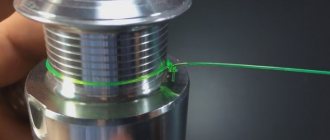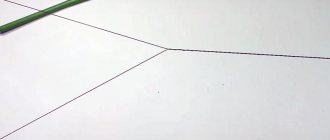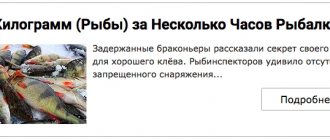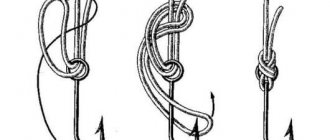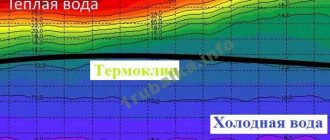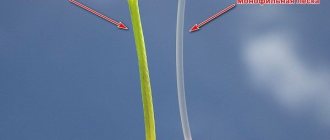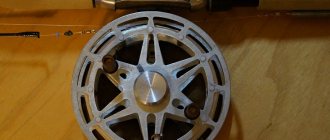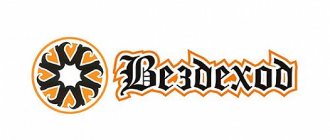Feeder equipment is becoming increasingly popular due to its ease of use and the ability to catch large fish. Feeder fishing is sensitive and easy to detect bites. Symmetrical and asymmetrical feeder loops are ways to mount gear to a fishing rod. Loops are classified as shaped accessories; they are easy to make, but require strict adherence to the instructions. They are somewhat more complex than a standard Gardner or paternoster knot, but can be knitted even by beginners.
Asymmetrical loop
Content
It is better to prepare fishing gear for fishing before fishing. The asymmetric loop for the feeder is made using different technologies, one of them:
- We prepare 1-1.5 m of monofilament, which we fold in half.
- Using a “surgical loop”, stepping back slightly (5-10 cm) from the area with the bend of the fishing line, we tie a small loop. There should be 2 free edges.
- We twist 10-15 cm, we knit the ends with the same knot.
- We string a swivel with a clasp onto the fishing line. The bend in the form of a twist should be on the side with an indentation of 5 cm.
- We measure the length of the loop, select 15-20 cm and tie a locking knot.
- The last stage is a knot using a swivel, which is attached to the main fishing line.
In such equipment, the feeder is attached to a longer arm.
The unit for the feeder equipment is installed correctly if the feeder moves freely from the point of twisting to the beginning. Using a swivel, long leashes are attached. To prevent the tackle from becoming tangled, it is better to trim off all remaining ends.
If the bite is passive, it is worth increasing the length of the loop, and with active bites you can reduce it. During the casting process, the line is pulled under itself. After casting and reaching the bottom, the feeder with equipment moves to the edge of the fishing line.
You can use different types of rigs, but the asymmetrical one is most popular for catching bream, roach, carp and other species.
Manufacturing of feeder equipment “symmetrical loop”
We will need:
- main line (monofilament)
- 2 swivels with clasp
- feeder weight
- fluorocarbon leader line
- hook
The knitting process is very simple:
- you need to fold the main line in half and start twisting by rotating both ends of the line in one direction;
- achieve 5-10 cm of tight twist and make a knot (the right twist in the picture is ready);
- then insert a swivel into one of the fishing lines, we will hook the feeder to it and step back 20 cm (this will be our main loop);
- make a knot;
- and again we make a twist, and at the end either a loop or attach another swivel, then you get 3 swivels per tackle;
- to this last loop (or swivel) we tie a 30-100 cm leash;
- Attach a hook to the end of the leash;
The gear is ready, all that remains is to attach the feeder to the swivel, which is located inside a large symmetrical loop, and the main fishing line will be attached to the very first swivel (in the picture on the right). It can be inserted into a loop using the loop-to-loop method.
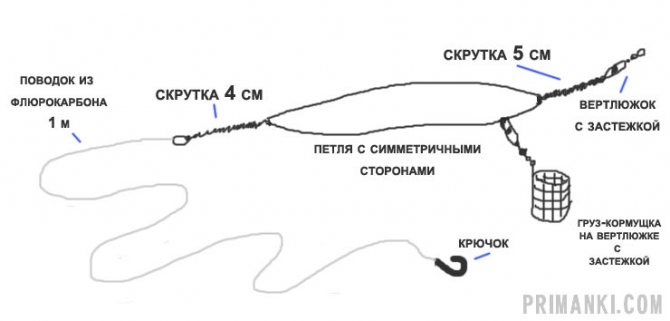
How to properly tie an asymmetrical loop for a feeder, what is its advantage and why bream hooks itself when fishing with this equipment.
Feeder rigs – a guide to all popular feeder rigs, their advantages and disadvantages.
Fishing for crucian carp on a feeder - what bait and bait to use, where to look for crucian carp in spring, summer and autumn.
Feeder tackle and installation
Do-it-yourself feeder equipment is made using the following components:
- rod;
- feeder reel with spinning line;
- feeder;
- equipment
The biggest differences exist in the equipment - this is the element of the tackle, which is located closer to the end of the fishing line, intended for attaching a leash with a hook and a feeder.
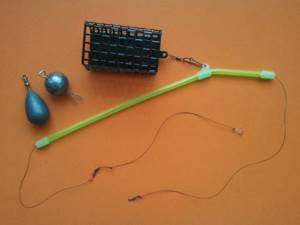
She feels good on both hard and soft bottoms.
The installation methods are different; the symmetrical loop for the feeder has been improved due to its shortcomings. A symmetrical loop has 2 equal ends. Due to its size, the bait is more noticeable to fish and creates vibrations that scare away fish. Making a feeder with a symmetrical loop is an inconvenient procedure; tying a knot directly on a pond can be difficult.
Thanks to the reduction in the size of one arm, the tackle has become more sensitive and almost invisible to the fish; there are no vibrations that could alert the individual. This is how an asymmetrical loop on the feeder appeared. Both varieties are equipped with weights and anti-twisting devices.
Types and types of installation
Common types of feeder installations:
- large symmetrical loop. It is used infrequently due to design flaws, but is recommended in places with active biting, as it cuts off fish;
- asymmetrical installation. It is sensitive and invisible to fish;
- Gardner rig. It is the simplest and most popular method, although it is not classified as a self-hooking type, but it provides a strong fish hook. The essence comes down to attaching the feeder to a twist of 10-15 cm fishing line;
- The inline installation method involves free movement of the feeder along the fishing line. Easy to install, but has less sensitivity compared to the Gardner loop. When casting over long distances, the line may overlap with the leash and feeder. The inline method is ideal for fishing in still waters with close casting;
- loop in a loop. A fairly simple method - the leash is loop to loop, loops are formed on the main line and the leash, one is threaded into the other, and then secured with a hook.
Read more
How to catch bream on a feeder
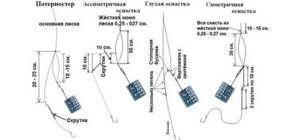
Feeder rod is designed for bottom fishing
Gardner's loop is a type of paternoster
- The feeder equipment is a Gardner loop in terms of the mechanics of its operation - the same as a paternoster, or in our opinion - a blind feeder at the end of the fishing line and a retractable leash. It’s just that, unlike the bottom outlets we are used to, this equipment is more effective. A hook is made to the leash from a thick fishing line, the same one that is used as the main one.
- The length of the branch exceeds the length of the fishing line to the feeder and ends with a loop into which the leash is attached. In general, the leash together with the outlet turns out to be much longer than the distance from the point of its attachment to the base to the feeder. But, thanks to the thick, rigid and long lead, it does not get tangled when casting or reeling in the feeder.
- The Gardner paternoster for the feeder differs from the classic one only in that the outlet to the feeder is made on a loop. In the classic form, this shoulder is made from a weaker and thinner fishing line - specifically so that when hooked, the feeder comes off, and not the leash with the fish.
- According to legend, the famous fisherman Steve Gardner from England came up with this rig when he watched his wife while fishing for a long time could not tie a regular installation on a tap. In England, this editing is simply called “Loop”, which means “loop”. And already in our country this type of paternoster is called the Gardner loop.
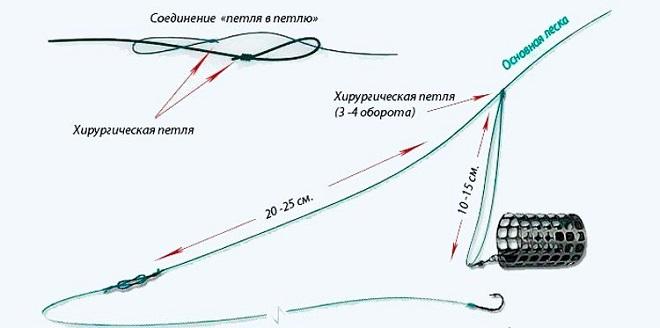
Which is better, a Gardner's loop or a classic paternoster? In terms of operation, these are absolutely identical installations. The Gardner rig is easier to knit - one knot to form a loop. At the remaining end there is a loop for a leash. We don't need the function of tearing off the feeders. On the contrary, it’s better to let the fish come off when hooked than to tear off an expensive feeder. It’s just that the classic paternoster comes from England, from a time when feeders were not yet used, and losing a cheap sinker instead of a fish was considered normal there. Read more about paternoster feeder equipment.
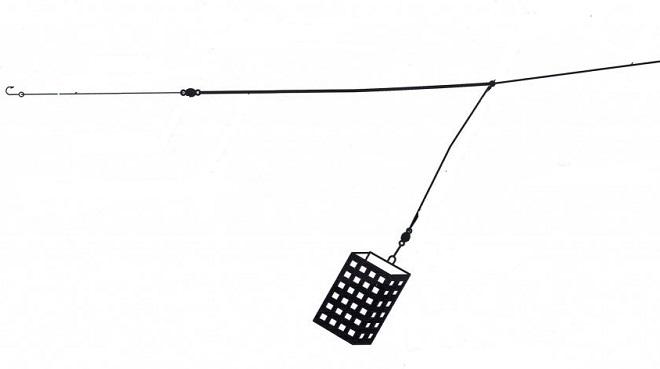
Regular paternoster
Features of an asymmetrical loop
Knots for feeder equipment vary in strength, inconspicuousness, tendency to twist, and simplicity of design. A distinctive feature of asymmetrical installation is the reduction of one shoulder in comparison with the other. Monofilament fishing line is used for knitting; a swivel is used to connect to the main fishing line. Thanks to its special design, it is resistant to twisting, which the paternoster encounters.
The main difference between asymmetrical installation is the principle of operation. The feeder is thrown into the water, the sagging of the main section of the line subsides and tension occurs. Along a level line, the feeder gradually moves down, where the fish swallows the bait. Immediately after reaching the end of the loop, the tip of the rod starts bouncing, this is a signal of a bite.
It is better to use an asymmetrical knot if:
- fishing is carried out in stagnant bodies of water, without fast currents;
- there are small fish;
- the fish does not bite well due to satiety or caution.
Not only bait is important when fishing, but also the correct choice of knots. Asymmetrical installation is more difficult than paternoster (it can be done in 1-2 minutes), it is better to knit at home.
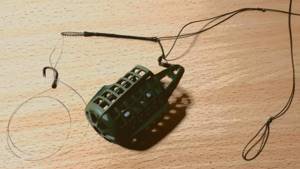
The asymmetrical loop is effective both in still water and in high currents
Gear used
Rod
The main characteristics of a rod for feeder fishing include:
- length;
- maximum weight of cargo/feeder;
- rigidity;
- build.
There is a division of all fishing rods into pickers and feeders. As a rule, fishing on feeders is done using feeders, and on pickers - using sinkers. In any case, the choice of weight depends both on the characteristics and class of the rod, as well as on the preferences of the fisherman and fishing goals.
Picker rods usually have a length of up to 3 meters, feeder rods - over 3 meters.
fishing line
Currently, there are two main types of fishing lines: monofilament and braided. The type of fishing line used for feeder fishing depends on the characteristics of the reservoir and the main species of fish that are found in it. Braided fishing line has little stretch and has less windage in the water and a longer casting range compared to monofilament line with the same breaking load.
If, for example, you plan to catch carp weighing 2 kg or more, the low stretchability of the braid will not allow you to absorb jerks during fishing and will increase the likelihood of the fish leaving, so a stretchable monofilament would be preferable. But when fishing for bream with a long cast, especially in the current, the stretchability of the monofilament line will negatively affect the hooking, while the braided line will allow you to clearly hook the fish with a short movement of the rod.
Coil
The coil on the feeder must have a high gear ratio. Feeder fishing is characterized by frequent recasts even in the absence of a bite due to the need to replenish the fishing point with bait. The reel must have a large spool in diameter to ensure a good casting distance. It is desirable to have a shallow “match” spool, convenient for thin fishing line. It is desirable to have a fishing line tuck on the spool, which is convenient to use to fix the casting distance. Another main criterion for choosing a reel is the quality of the friction brake.
Bite alarm
There are a great variety of bite alarms for feeder fishing. There are mechanical and electronic alarms by type, and visual and audible ones by mode of action. There are also direct bite alarms, to use which you need to be within their hearing/visibility, and remote ones, which send a signal to one or another intermediate device (for example, a pager).
The choice of one or another bite alarm depends on the preferences of the fisherman,
Sinker
In feeder fishing, bottom sinkers are used if you need to cast without a feeder, which is usually weighted enough to hold the tackle at the desired depth.
Feeder
The purpose of the feeders is to deliver bait to the fishing point to attract and retain fish at one point in the pond. The choice of feeder depends on the fishing conditions and habits of the fish. It is important to have a supply of feeders with you and experiment with them - otherwise it will be difficult to attract and keep fish in one place. Functionally, feeder feeders are divided into several types:
- feeders for starter feeding;
- feeders for long-distance casting;
- supplementary feeders for standing water;
- supplementary feeders for currents;
- feeders for live food.
Also, feeders can be divided into types according to the method of attachment to the equipment and according to design features. The first ones can be sliding, remote on a separate leash and end. The second ones are open, semi-closed and closed. Feeders can also be light and loaded with lead. They vary in volume - from a tablespoon for light tackle to holding about half a kilogram of bait for super-heavy rods.
Leash
For leashes, high-quality monofilament or fluorocarbon fishing line with a diameter of 0.12 to 0.18 mm is usually used.
The diameter of the fishing line is selected depending on the size of the fish being hunted. The larger it is, the larger the diameter should be.
For leashes, you should select a soft line without memory with a good breaking load and the smallest possible diameter. On sale there are special leash lines from different companies wound in lengths of 20 - 25 meters. They are generally of better quality than regular large spool lines.
Properties of an asymmetrical loop
Thanks to the asymmetry, influences that wary fish perceive as a threat are not transmitted to the feeder. Even rain and wind can scare the fish, not to mention the impacts and vibrations of the water. When using a paternoster, all influences are transmitted through the fishing line to the feeder, and the asymmetrical installation eliminates such influence. If you want to catch a triple or just a large fish, this phenomenon should be minimized, since a twitching feeder will scare away the fish.
Immediately after swallowing the bait, the fish does not feel resistance to movement. Thanks to the slower understanding of what happened, she is hooked more deeply and confidently. After colliding with the feeder, the fish self-hatches.
An important advantage of an asymmetrical loop is the possibility of repeated use if the knot was not broken during the fishing process. When tied correctly, the loop lasts about 3 fishing trips. Before the trip, it is better to prepare 3-4 equipment.
Advantages and disadvantages
The advantages of asymmetrical installation outweigh the disadvantages; such a loop belongs to the basic equipment; every self-respecting fisherman should be able to make it.
The advantages of fastening include:
- increased sensitivity, bites from neat or small fish are felt;
- often used for fishing in fast water conditions, because it allows you to catch fish on your own;
- thanks to the long leash, the fish bites and at first does not feel danger;
- used for passive fishing in stagnant waters;
- The leash and feeder do not get tangled.
Read more
What is an anti-twist for a feeder?
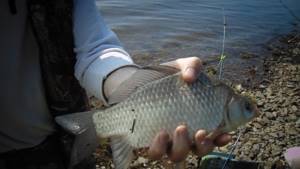
The ease of casting and retrieving caught fish guarantees positive emotions
Among the disadvantages of asymmetrical fastening:
- knitting and installing a loop is somewhat more complicated than a traditional paternoster;
- long leashes for novice anglers can lead to tangling of the fishing line;
- used in reservoirs without silt and tall thickets;
- the equipment includes additional elements;
- the fish does not self-hook in quiet waters, the fisherman has to constantly monitor the bite.
If the result is unsatisfactory, you can experiment: change the length of the leashes, the type of fishing line, the weight of the feeder structure.
How to knit an asymmetrical loop for a feeder?
Even within the method of knitting an asymmetrical loop, there are several modifications and modifications to the installation. Each option is used to eliminate overlap and increase the elasticity of the lead on the bend. It is better to use the well-known method of knitting an asymmetrical loop for a feeder, which has proven its effectiveness many times.
During the work, you will need a rigid piece of fishing line with a cross-section of 0.2-0.4 mm and a length of 1-1.5 m. It is better to choose rigid types of fishing line; fluorocarbon is most often used. To check the rigidity, you should wind a couple of turns on your finger and release, a suitable fishing line will immediately unwind.
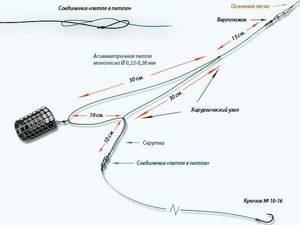
This type of equipment can be used both for fishing without a feeder with a picker or sinker, and with a feeder
Classic knitting method:
- We take a piece of fishing line and bend it in half, but one side should be made 10 cm shorter than the other.
- To create a strong loop, use a triple or at least double knot; you should get a small loop to secure the leash.
- We twist the fishing line (length 10-15 cm) and double knot at the end. This is the most critical stage; the quality of the leash depends on it. Ideally, it turns out hard and dense. During the process, you should get an asymmetrical knitting.
- A swivel with a built-in clasp is threaded through the long piece to secure the feeder.
- Select the length of the loop (from 30 to 70 cm) and tie a double knot.
Materials for production
The fishing line for an asymmetrical loop is used rigid, monofilament or fluorocarbon, with a diameter of up to 0.4 mm. Checking whether it is suitable for making a loop is quite simple - make a few turns of the fishing line around your finger and sharply release it; the one that is suitable in terms of rigidity will immediately straighten out.
Remember that the entire result of feeder fishing depends on the correctly selected fishing line.
«>
A properly made leash will not only protect the main line from breaking, but will also prevent the loss of other parts of the installation. There are several general rules for choosing fishing line for a leash:
- It must be durable in order to withstand not only the jerks of the fish being fished out, but also cope with all kinds of hooks, within reason, of course. But its strength should not exceed the strength of the main fishing line, so that if something happens, all the equipment is not lost.
- It should be resistant to mechanical stress - simply put, it should not fray during the first casts on the rocky bottom.
- It should be as little noticeable as possible to the fish. In some reservoirs, due to the characteristics of the bottom topography and the color of the water, it will be more advisable to choose colored or even black fishing line.
- When fishing in a strong current, the line for the leash should be of negative buoyancy so that the leash quickly sinks to the bottom following the feeder, and does not “bubble” with the current.
When going fishing, it is better to have with you a number of ready-made equipment with leashes of different lengths and stiffness, so that you can not only quickly repair broken tackle, but also experiment with casting. The main rule of the feeder: the worse the fish bites, the longer the leash needs to be made. This is, in principle, true, but you shouldn’t rush to extremes - a meter-long leash will be enough. Its large length will cause overlaps and tangling of the entire equipment.
Where is an asymmetrical loop used?
An asymmetrical fishing loop is used for catching most types of non-aggressive fish:
- carp;
- bream;
- tench;
- roach;
- crucian carp, etc.
It can be used both for bottom fishing in conditions of a clean bottom and in thick thickets. Even with strong currents, asymmetrical mating is used, but it is important to correctly determine the feeder. With the correct execution of the knot and selection of gear, the fisherman can cast 50 m.
